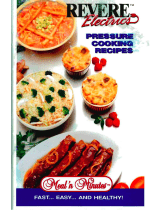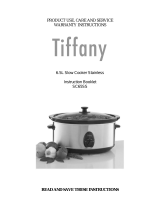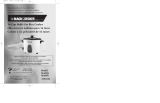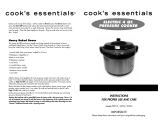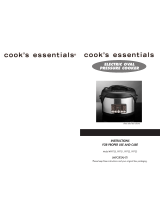
6
Reminder: When cooking any food, do not let any portion extend
above the maximum ll mark. When cooking rice, grains, dry
beans and peas, soups, and stews, the cooker should never be
more than ½ full.
2. Always add cooking liquid. — If an empty pressure cooker is left on a hot burner or if a cooker boils dry and is left
3. Always look through the vent pipe before using the cooker to make sure it is clear. — If the vent pipe is blocked,
clean the vent pipe, see page 7.
4. Always fully close the pressure cooker. — The cooker is fully closed when the cover handle is directly above the
when the cooker is fully closed. However, if the cooker is not fully closed, the lugs cannot lock the cover onto the
body. It’s possible that pressure could build inside the cooker and cause the cover to come off and result in bodily
Do not turn past handle alignment.
5. Never open the cooker when it contains pressure. — The air vent /cover lock provides a visual indication of
pressure inside the cooker. When it is up, there is pressure. When it is down, there is no pressure in the cooker and it
can be opened. If the pressure cooker is opened before all of the pressure is released, the contents of the cooker will
erupt and could cause bodily injury or property damage.
6. Replace the overpressure plug if it is hard, deformed, cracked, worn or pitted, or when replacing the sealing
ring. Replace the sealing ring if it becomes hard, deformed, cracked, worn, pitted, or soft and sticky. — The
the cooker cover in the event that the vent pipe becomes blocked. The overpressure plug is made of rubber, and when
replaced immediately.
Do not attempt to use the released overpressure plug.
7. Always follow special procedures found in the instruction book when pressure cooking rice, grains, and dry
beans and peas. — During cooking, dry beans and peas tend to froth and foam which could cause the vent pipe to
become blocked. Therefore, dry beans and peas need to be soaked and cooked according to instructions beginning on
page 29. Using this method will keep foam at safe levels during cooking. Like dry beans and peas, rice and grains tend
to froth and foam during cooking; therefore, to contain foaming and frothing during the cooking period, rice and grains
must be prepared in a bowl in the pressure cooker according to directions on page 31.
8. Never pressure cook applesauce, cranberries, rhubarb, cereals, pastas, dried soup mixes, or dry beans and peas
which are not listed in the chart on page 29.
they should never be cooked under pressure.
CleanInG
1. All parts of your pressure cooker, including the sealing ring and pressure regulator, are fully immersible for easy
cleaning. When washing the unit, however, the sealing ring should always be removed to allow easy cleaning of the
inside rim of the cover. The sealing ring should be washed with hot, sudsy water after each use.
2
⁄
3
ll line
1
⁄
2
ll line
Fig. M




















